Raymond Lawrence Foley
Inductee Hall of Fame 10/12/2011
Ray Foley will be remembered as one of Tasmania’s finest Greyhound administrators, serving as permanent part time Secretary of the Launceston Greyhound Racing Club for twenty two years, but also as the founder, financier and long term editor of the “Bible of Tasmanian Greyhound Racing”………The Greyhound Guide.
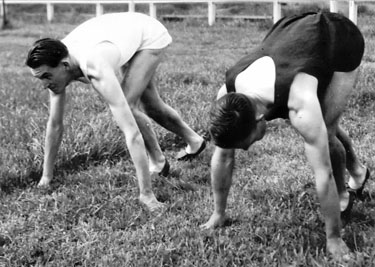
Bill Emmerton (left) and Ray Foley
Ray Foley was born on January 27 1917, the youngest of ten children. Educated at St Patricks College in Launceston, this good student showed great sporting prowess from an early age. A fine track and field athlete, he excelled as an amateur sprinter, before turning professional and competing against famous names such as Bill Emerton, best remembered for his “Death Valley” run in America.
One family story of Ray, was his effort to run third in a Burnie Gift during World War Two, with a bandaged foot, burnt by a crucible of molten lead at his work, making specialist parts for the war effort in New Guinea.
Ray, along with his brothers Len and Leo, was also an excellent cyclist, both here and on the Mainland. In one particular Road race from Cleveland to Launceston, the three brothers filled first, second and third with less than a wheel between the three of them. Some kind of a first no doubt!
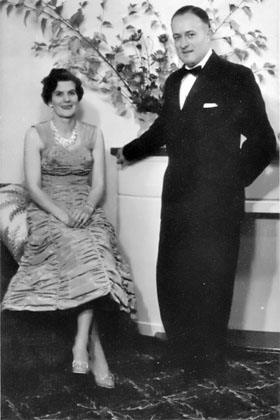
Ray and Joy Foley
Ray married Joy Smith in 1940 and had a daughter Carolyn and son Raymond. A devoted family man, he was said to have brushed aside many opportunities in life to spend time with Joy and his children.
Ray Foley was a man of great business acumen, and created a manufacturing and engineering company, Foley Industries, specializing in stainless steel fabrication. It remained in the family for fifty five years, receiving numerous accolades including Exporter Of The Year, for products sent to South East Asia.
A fine community man, Ray employed a number of displaced people, especially from Hungary and other war – torn countries, and along with Joy, was a long standing member of the South Launceston Rotary Club.
From early in the 1940’s, Ray Foley showed a great interest in Greyhound Racing. He owned a number of successful greyhounds, and became increasingly involved with the Launceston Greyhound Racing Club. He saw a need in greyhound racing, for the industry to have its own publication, and, supported by the L.G.R.C. and the H.G.R.C., Ray brainchild “ The Greyhound Guide” commenced production in 1950.
Until the final edition on July 26 1985, this became the focal point for the most comprehensive form, fields, news and advertisements on all things Greyhound Racing in Tasmania. From the original office in Charles Street, Launceston, opposite Foot & Playsted Printers (who printed the guide for the entire thirty five years of its existence), Ray’s greyhound weekly became the “must have”, of greyhound participants the length and breadth of this State.
Walter Bond, Ray’s Brother in Law, and later founding Secretary of the D.G.R.C. was initially the Editor under Ray’s guidance, but when Bond went to Devonport in early 1952, the founder of the Guide also became the Editor until its final copy. Ray took great pride in the publication, and praised Foot & Playsted in his final edition, for never once missing having the guide out on time.
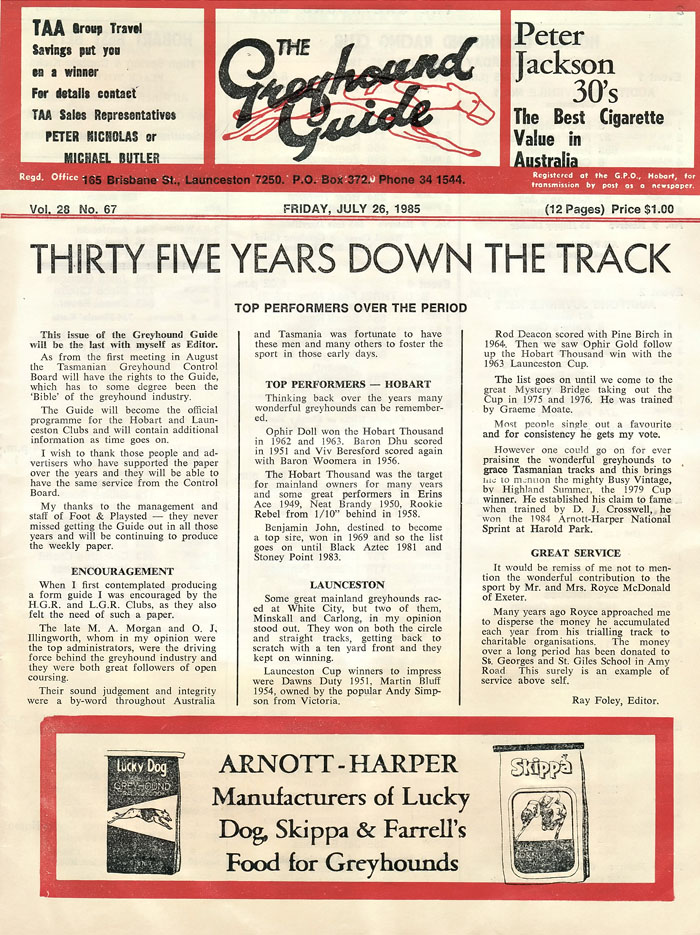
Final Edition of The Greyhound Guide
Ray and his son became good friends with their staff, printers and linotype operators, all of this before the computer age. Ray Foley Junior recalls a Launceston Newsagent telling him how on Thursday afternoons at 4pm, there would be a long line up of people and vehicles waiting for that week’s copy of the Greyhound Guide. The guide was delivered by bus to the North West Coast, to Hobart and every small town on the way, where there was an interest in our sport. Ray Foley was a busy and astute business man………but The Greyhound Guide was a labour of love, and a source of great pride, and every participant in greyhound racing in this state owes a legacy to his dedication and quality of production.
During the 1962-63 season, “Mick” Sturges, the founding secretary of the L.G.R.C. died and in May 1963 Ray Foley took over as permanent part time Secretary of the Launceston Club, a role he maintained until ill health forced him to step down in 1985. His capacity for hard work saw him run a successful business, produce the Greyhound Guide every week, and become one of the best and most liked Secretaries of any Greyhound Club in this State’s history.
For two decades Ray Foley ran a most efficient L.G.R.C and oversaw a stable period in the Club’s history. He was also a former member and later Treasurer of the National Coursing Club, and became Launceston’s inaugural delegate on what is now the Australian Greyhound Racing Association.
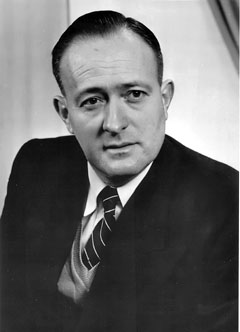
Ray Foley during his years as Secretary of the L.G.R.C.
As L.G.R.C. Secretary, Ray oversaw many positive changes at the Club. He took the Club from an 829 pound deficit to profit within two seasons, and his early years saw significant stakes increases. Always community minded, Ray allowed the middle of White City to be used by the Northern Junior Soccer Association and the Northern Amateur Athletic Association, for a very minimal charge. In 1967-68 he oversaw the change to eight dog fields, and heavily promoted handicap distance racing.
A successful 1968-69 season saw stakes rise again, with particular emphasis to Juvenile and Trial Grades. Charities were always supported, in particular Red Cross, Anzac Day Trust and St. Giles. Despite early rejection of a T.A.B., the Launceston Club continually supported its inception, which came to fruition in the 1974-75 season. Ray’s involvement here was significant. This season also saw the change to owners and trainers handling their own greyhounds on race night.
Ray’s time saw many changes to White City, including better access from Lamont Street, sealed parking, improved public amenities and better lighting. The Seventies also saw a new running rail, new Tote and Bookmakers area, plus the Club gaining a liquor licence during the 1975-76 season. In 1978-79 Ray oversaw the change to the Bramich Lure.
Ray Foley was great friends with Henry Harrison, one of Australia’s most respected administrators, and Ray’s hard work at a National level saw Launceston host the 1981 National Distance Championship, won by Shamrock Jewel. The L.G.R.C. remains the only club outside of a Capital City, to have hosted the Nationals.
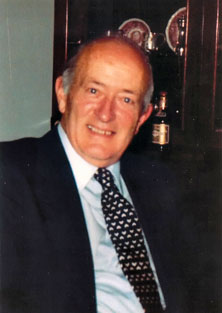
Ray in later years
Ray’s time as Secretary also saw The Tasmanian Derby and Tasmanian Oaks inaugurated in the 1973-4 season, initiation of some television coverage of racing at White City, as well as a Miss Greyhound Racing competition which was covered live on TV, exposing our sport to a far wider audience.
Ill health saw Ray Foley stand down as L.G.R.C. Secretary in 1985. He retained a keen interest in his beloved greyhound racing, as well as remaining busy with Foley Industries, and finding time to fly fish and race thoroughbreds (Century Proof and Wave Royale had great success)with his wife Joy and son Ray.
Ray Foley died on September 4 1988, in his seventy second year. Richard Stamford, who worked with Ray for most of his time at the Launceston Club, recalls Ray as a most quiet, polite, church like character with strong resolve. Between his work with the Launceston Club and the Greyhound Guide, Ray has left a legacy to greyhound racing in this State, that has been matched by very few.
He was awarded Life Membership of the L.G.R.C. at the 1984-85 Annual General Meeting, and at a later date, the Committee named the new White City grandstand “ the Ray Foley Stand”. As a further mark of respect, the L.G.R.C. annually runs the Ray Foley Perpetual Trophy over his beloved long distance. So deservedly, Ray Foley now takes his place in Tasmania’s Greyhound Hall of Fame.

0 Comments